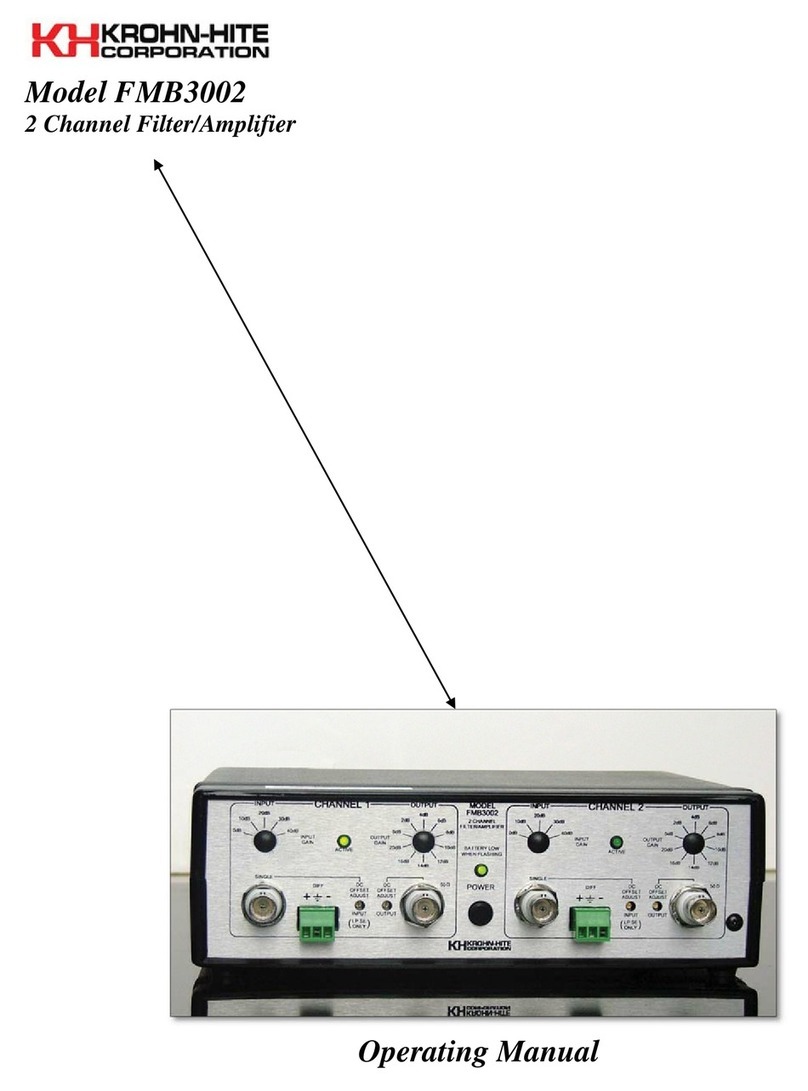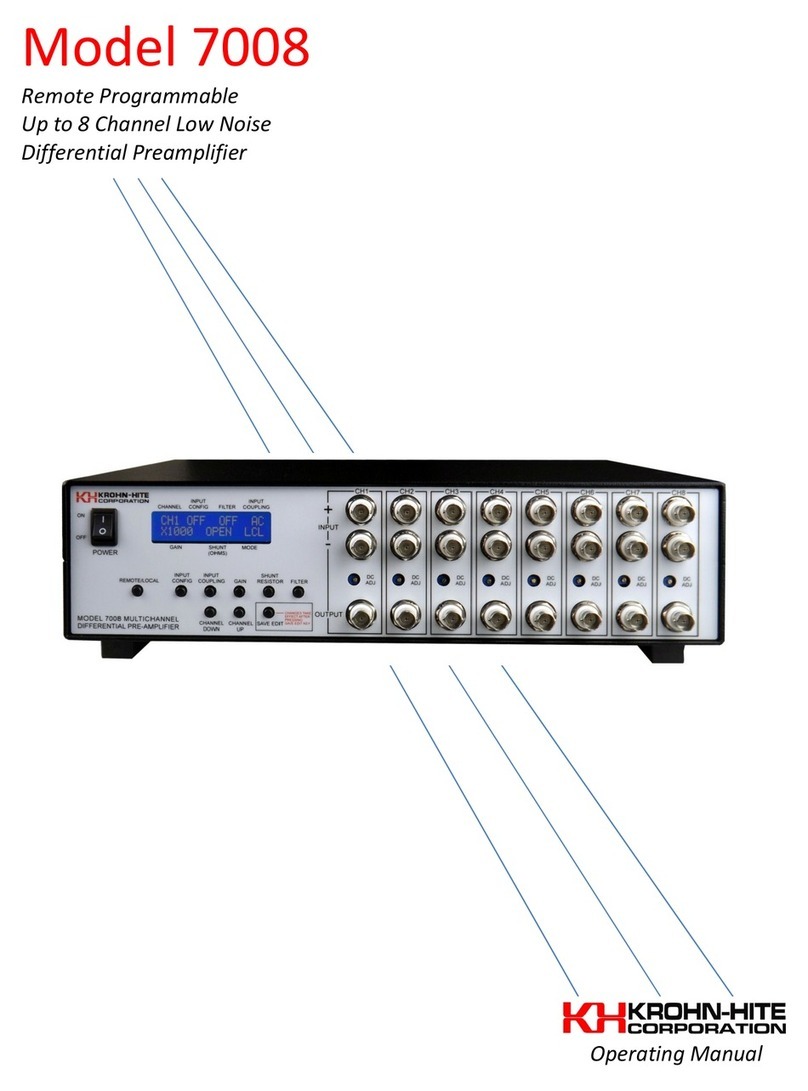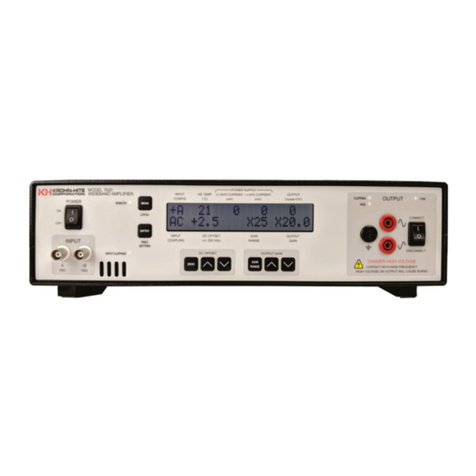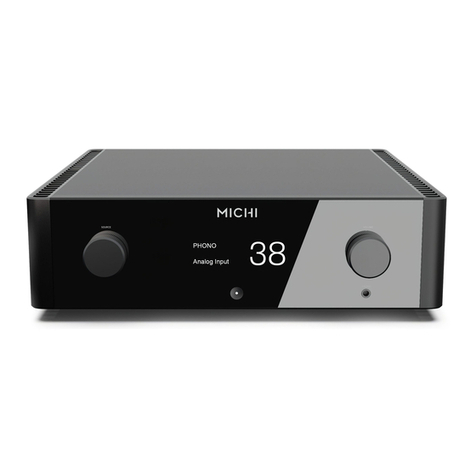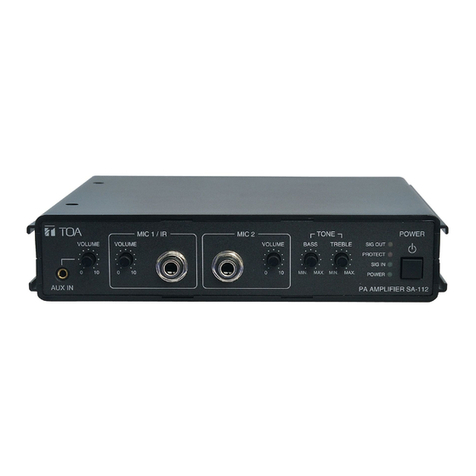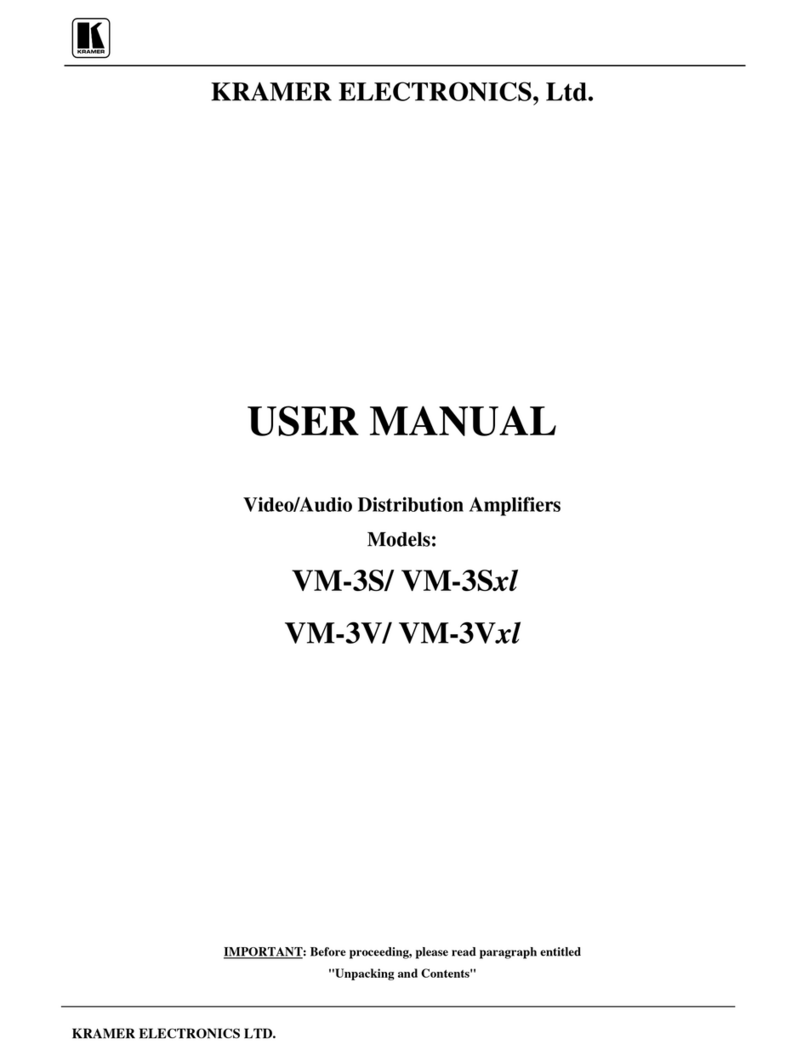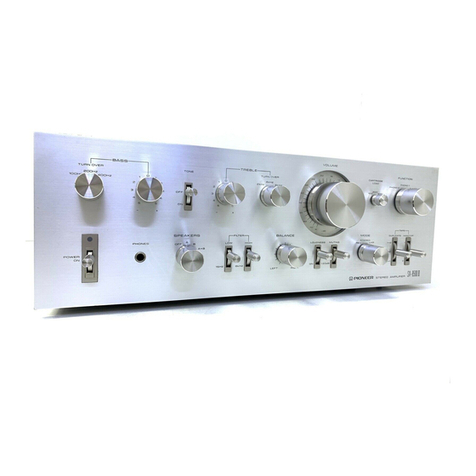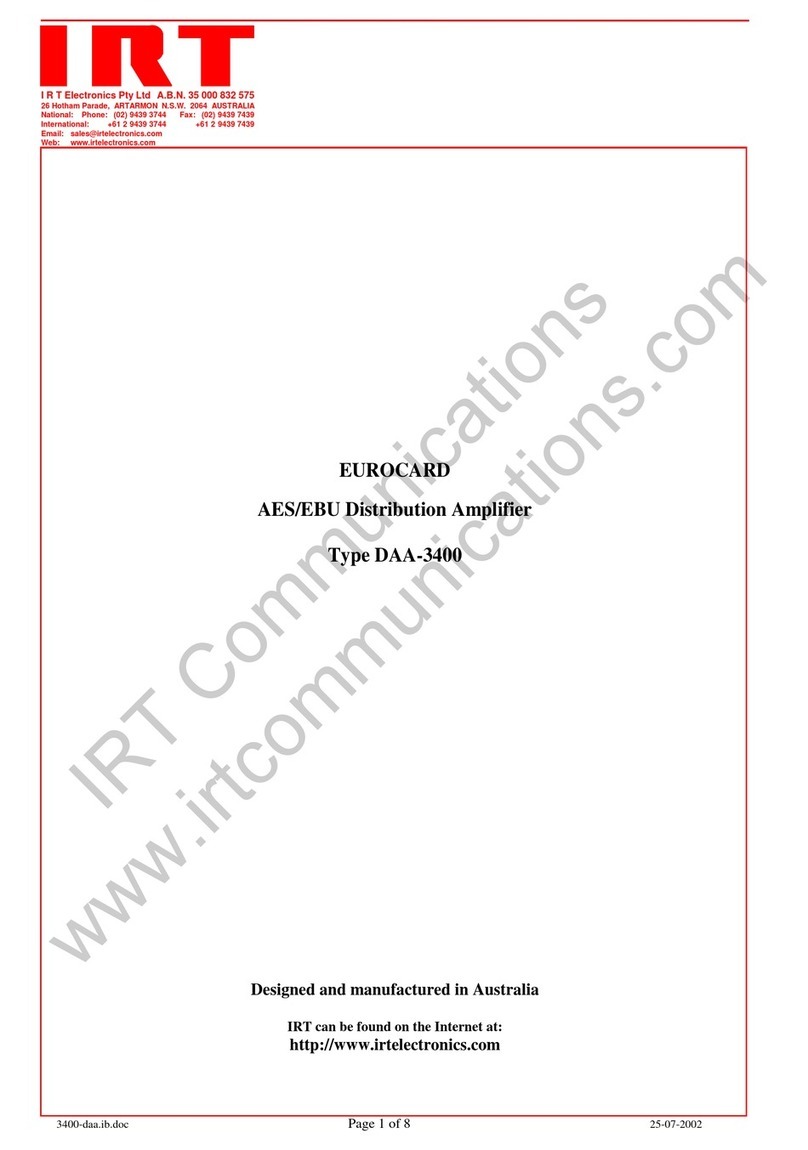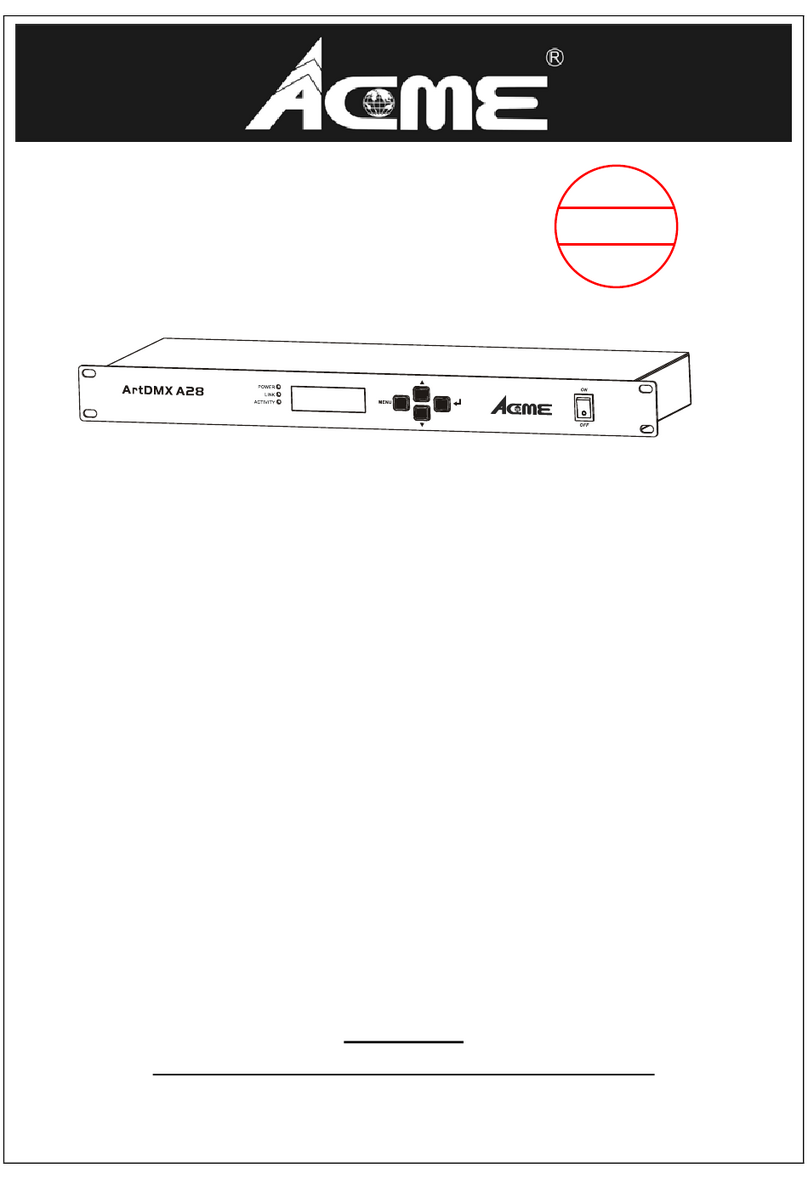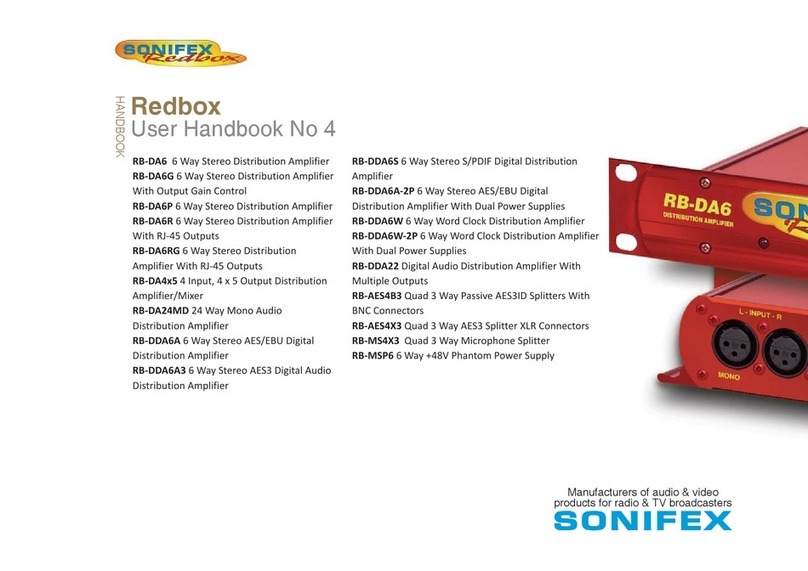Krohn-Hite 7500 User manual

Model 7500
DC to 1MHz
Wideband Power Amplifier
Operating Manual
Copyright 2004. All rights reserved. Contents of this publication may not be reproduced in any form without the written
permission of Krohn-Hite Corporation. Printed in U.S.A. 8-04
Unit 4, 15 jonathan Drive, Brockton, MA 02301-5566 U.S.A.
Tel: (508) 580-1660; Fax (508) 583-8989
email: info@krohn-hite.com; web: www.krohn-hite.com

Notes

DC to 1MHz
WIDEBAND POWER AMPLIFIER
MODEL 7500
CONTENTS
Section Page
1GENERAL DESCIPTION....................................................................................1
2OPERATION......................................................................................................9
3INCOMING ACCEPTANCE AND PERFORMANCE CHECK...............................13
ILLUSTRATIONS
Figure Page
1Model 7500 Amplifier..........................................................................................ii
2Typical Average Power Output vs Frequency Curve .............................................4
3Typical RMS Voltage Output vs Frequency Curve ................................................5
4Typical RMS Output Current vs Frequency Curve.................................................5
5Typical Distortion vs Frequency Curve.................................................................6
6Typical Frequency Response Curve ....................................................................6
7Response to Square Wave Input .........................................................................7
8Operating Controls, Connectors and Indicators.....................................................8
9AC Input Wiring Diagram ....................................................................................9
10 Output Current Limiting Curve...........................................................................12
11 Test Setup for Measuring Power Output.............................................................14
i

Model 7500 Wideband Power Amplifier
ii

Section 1
–
General Description
__________________________________________________________________________________________
SECTION 1
GENERAL DESCIPTION
1.1 INTRODUCTION
The Krohn-Hite Model 7500, shown in Figure 1, is an all solid state, direct coupled amplifier, that
provides 75 watts of continuous power (150 watts at DC), at 125 volts RMS, from DC to 100 kHz.
Frequency response of the 7500 is flat to within 0.1db, and harmonic distortion at full power output is
less than 0.1%, from DC to 10 kHz. A front panel control selects 20 db (10) or 40 db (100) of fixed
gain, or zero to 40 db of continuously variable gain. The output of the 7500 can be offset ±200 volts,
open-circuit, by means of a front panel DC offset control. The 7500 provides selectable input coupling,
either direct (DC) or capacitive (AC).
The amplifier’s output is protected from short-circuit or other abnormal load conditions by a unique
output protection circuit, that uses a modified form of foldback current limiting. The output stage is
convection cooled by a special heat sink configuration.
An optional rack-mounting kit (part no. RK-519) is available for installing the unit in a standard 19” rack
spacing.
The amplifier is carefully inspected, aged and adjusted before shipment, and should be ready for
operation when it is unpacked. If it appears to have been damaged in shipment, make a claim with the
carrier, and notify Krohn-Hite immediately.
1.2 SPECIFICATIONS (Specifications apply after a 30 minute warm-up.)
Frequency Range
DC to 1 MHz
Output Power, Voltage & Current (Specifications apply using a 200 ohm resistive load):
Power: 75 watts, DC to 100 kHz; 40 watts at 500 kHz; 10 watts at 1 MHz.
Voltage: 125 volts RMS, DC to 100 kHz; 90 volts RMS at 500 kHz; 45 volts RMS at 1 MHz.
Current: 625 milliamperes RMS, DC to 100 kHz; 450 milliampers RMS at 500 kHz; 225
milliamperes RMS at 1 MHz.
Frequency Response
Flat to within ±0.1 db, DC to 1kHz; ±1.5 db to 500 kHz; -3 db at approximately 1 MHz.
Harmonic Distortion
At 75 watts into 200 ohms, less than 0.1% to 10 kHz, approximately 1.5% at 100 kHz.
Voltage Gain
Fixed, 20 db ±0.2 db (X10) or 40 db ±0.2 db (X100), or continuously variable, zero to 40 db.
1

Model 7500 Amplifier
__________________________________________________________________________________________
Gain Stability
Less than ±0.1 db change for a 10% change in line voltage.
Dynamic Range
Greater than 85 db.
Phase Shift
Zero ±1 degree from DC to 10 kHz. Phase shift increases linearly to 100 degrees (lagging) at
1 MHz.
Square Wave Response (At 100 Vp-p into 200 ohms)
Risetime, less than 500 nsec, overshoot less than 5%. Zero droop in DC coupled mode.
Maximum Input Voltage
±20 volts peak in the VARIABLE and X100 GAIN positions; ±200 volts peak in the X10 GAIN
position.
Maximum DC Component
±200 volts (except VARIABLE GAIN position) in the AC position of the INPUT COUPLING
switch.
Input Sensitivity
1.5 volts RMS at maximum gain setting.
Input Coupling
Either direct (DC), or capacitive coupling (AC) with low frequency cutoff at approximately 1 Hz.
Input Impedance
1 megohm in parallel with 85 pf in fixed gain modes; 5,000 ohms in variable gain mode.
Output Regulation
No load to 200 ohms, less than 0.5%, DC to 10 kHz.
Output Hum and Noise (1 MHz Bandwidth)
Less than 4 millivolts RMS with input shorted; less than 10 millivolts RMS with input open and
shielded.
Output Coupling
Direct.
2

Section 1 –General Description
__________________________________________________________________________________________
Output DC Level
Normally zero volts. Adjustable.
Output DC Offset ( No Load)
Variable, zero to ±200 volts. Combined AC plus DC offset limited to ±200 volts.
Output DC Level Stability (After Warm-Up)
Vs. Line (short term): Less than 1 mv for 10% line voltage change.
Vs. Time: Less than 2 mv/8 hr.
Vs. Temperature: Less than 5 mv/°C.
Internal Impedance
Less than 1 ohm, DC to 10 kHz; less than 10 ohms at 100 kHz;l less than 75 ohms at 1 MHz.
Load Impedance
Capable of driving any load within the voltage and current limitations of the amplifier.
Load Power Factor
1.0 to zero, leading or lagging.
Ambient Temperature
o°C to 45°C.
Controls
Front Panel: POWER switch, 3 position push-button GAIN selector, variable GAIN control, 3
position push button DC OFFSET selector, variable OFFSET control, screwdriver control for
DC output level.
Rear Panel: CHASSIS/FLOATING ground switch.
Front Panel Indicators
Power ON, output OVERLOAD
Terminals
Front Panel: BNC for INPUT, binding posts for OUTPUT.
Rear Panel: BNC for INPUT, binding posts for OUTPUT, AC power receptable.
3

Model 7500 Amplifier
__________________________________________________________________________________________
Power Requirements
105-125 or 210-250 volts, single phase, 50-400 Hz, 85 watts quiescent, 400 watts maximum.
Fuse Protection
AC line, 5 ampere slow blow (115 V), 2.5 ampere slow blow (230 V); output stage unregulated
supplies, 1 ampere fast blow (each supply).
Dimensions and Weights
Model 7500: 16-5/8” wide, 5-1/4” high, 17” deep, 35 lbs/16 kgs net, 40 lbs/18.2 kgs shipping.
Optional Rack-Mounting Kit
Part No. RK-519: Permits installation of the 7500 into a standard 19” rack spacing.
1.3 PERFORMANCE CHARACTERISTICS
The performance characteristics of the Model 7500 are illustrated in Figures 2-7. Figure 2
represents the amplifier’s typical output power levels for different resistive loads. The
maximum power output of 75 watts is obtained with a 200 ohm load. Figures 3 and 4
represent the amplifier’s RMS voltage and current output, under similar load conditions. The
amplifier’s maximum output voltage is approximately 140 volts RMS, open-circuit. The
maximum output current is obtained with a 100 ohm load. Figure 5 shows the typical distortion
of the 7500 at full power (75 watts) output. Distortion in the 7500 is less than 0.1% over most
of its range. Figure 6 represents the frequency response of the 7500 for both open-circuit and
full power output conditions. The frequency response of the 7500 to a square wave input is
shown in Figure 7 (b); the input of the 7500 is shown in Figure 7 (a). Note that the amplifier
produces very little ringing or overshoot on the signal, and that there is little, if any, rounding of
the square wave’s corners.
4

Section 1
–
General Description
__________________________________________________________________________________________
Figure 2. Typical Average Power Output vs. Frequency, for Different Resistive Loads.
Figure 3. Typical RMS Voltage Output vs. Frequency for Different Resistive Loads.
5

M
odel 7500 Amplifier
__________________________________________________________________________________________
Figure 4. Typical RMS Output Current vs. Frequency, for Different Resistive Loads.
Figure 5. Typical Distortion vs. Frequency at Full Power Output.
6

Section 1
–
General Description
__________________________________________________________________________________________
Figure 6. Typical Frequency Response
Figure 7. Response to Square Wave Input
7

Mode
l 7500 Amplifier
__________________________________________________________________________________________
Figure 8. Operating Controls, Connectors and Indicators.
8

Section
2
–
Operation
__________________________________________________________________________________________
SECTION 2
OPERATION
2.1 POWER REQUIREMENTS
The Model 7500 Power Amplifier may be wired for operation from a single phase, AC power
source of either 105-125 volts, 50-400 Hz, or 210-250 volts, 50-400 Hz. When the amplifier is
wired for 105-125 volt operationg, the power transformer’s primary windings are connected in
parallel by installing jumpers between pins 1 and 3, and pins 2 and 4, which are located on the
transformer (figure 9a). A 5 ampere, slow-blow fuse is requred for 105-125 volt operationg.
When 210-250 volt operation is required, the primary transformer windings are connected in
series by placing a jumper between pins 2 and 3 (figure 9b). When the amplifier is wired for
210-250 volt operationg, a 2.5 ampere, slow-blow fuse must be used.
Figure 9. AC Input Wiring Diagram
2.2 OPERATING CONTROLS< CONNECTORS AND INDICATORS (See figure 8)
2.2.1 Front Panel Controls
POWER: On-Off toggle switch.
GAIN: 3 position push-button switch plus single-turn potentiometer for adjusting the amplifier’s
output voltage gain. The GAIN control provides a 20 db (X10) and 40 db (X100) fixed gain
mode, plus a zero to 40 db variable mode.
INPUT COUPLING: 2 position push-button switch for selecting direct (DC) or capacitive (AC)
coupling. In the AC mode, the low-cutoff frequency is approximately 1 Hz.
OUTPUT OFFSET: 3 position push-button switch for selecting zero, (+) or (-) DC offset, plus a
single-turn potentiometer for controlling the offset from zero to 200 volts peak, open-circuit.
9

Model 7500 Amplifier
__________________________________________________________________________________________
ZERO ADJ: Single turn screwdriver control for adjustment of the amplifier’s output DC level.
2.2.2 Rear Panel Controls
CHASSIS/FLOATING: 2 position slide switch that disconnects the amplifier’s signal ground
(⊥) from its chassis ground ( ⊥), when used in the FLOATING mode.
2.2.3 Connectors
FRONT PANEL: BNC for INPUT, binding posts for OUTPUT.
REAR PANEL: BNC for INPUT, binding posts for OUTPUT; AC power receptacle, chassis
grounding post.
2.2.4 Indicators (Front Panel Only)
POWER-ON: Neon indicator that lights to indicate a power-on condition.
OVERLOAD: Neon indicator that lights when the amplifier’s output voltage approaches
clipping as a result of an output overload.
2.3 OPERATION
2.3.1 Initial Set-Up
To operate the 7500 power amplifier, proceed as follows:
1. Make appropriate power connections (Section 2.1).
2. Set the OUTPUT OFFSET control to zero.
3. Set the GAIN selector to the VARIABLE position and GAIN potentiometer to the Max.
CCW end.
4. Set the INPUT COUPLING switch to the desired mode.
5. Connect a voltmeter to the OUTPUT and adjust the OUTPUT DC Level by means of the
front panel ZERO ADJ screwdriver control.
Select the desired GAIN and OFFSET modes, and make the appropriate connections to the
INPUT and OUTPUT connectors.
Allow a 30 minute warm-up to obtain rated performance specifications.
CAUTION!
The 7500 is capable of as much as 200 volts peak on its OUTPUT terminals. To
prevent the possibility of electrical shock, extreme caution should be used in
connecting or disconnecting any cable or load from the amplifier’s OUTPUT
terminals, whenever these voltages are present.
10

Section
2
–
Operation
__________________________________________________________________________________________
2.3.2 Gain Control
The GAIN control on the 7500 consists of a 3 position, push-button switch that selects 20 db
(10) or 40 db (100) of fixed gain, or zero to 40 db of variable gain controlled by a single-turn
potentiometer. The output voltage of the 7500 is in phase (non-inverted) with respect to the
input, in all three GAIN modes. A minimum input signal of 1.5 volts $MS is required to obtain a
maximum output voltage of 140 volts RMS in the 40 db FIXED or zero to 40 db VARIABLE
positions.
CAUTION!
The maximum allowable input voltage is ±20 volts peak in the VARIABLE and X100
GAIN positions, and ±200 volts peak in the X10 GAIN positions.
2.3.3 Output Offset Control
The OUTPUT OFFSET control consists of a 3 position, push-button switch that selects zero,
positive or negative DC offset. The positive or negative offset is controlled by a single-turn log
taper potentiometer and is adjustable from zero to ±200 volts peak, open-circuit. The
amplifier’s output can be offset ±200 volts DC plus AC peak. That is, if the amplifier’s AC
output is 50 volts peak, then the signal may be offset by 150 volts maximum. The smaller the
AC peak value, the greater the DC offset value. If no AC signal is applied to the amplifier’s
input, then the DC offset will provide a DC voltage on the amplifier’s output, adjustable from
zero to ±200 volts, open-circuit. In this condition, the amplifier may be used as an auxiliary DC
supply, within the amplifier’s specified limitations for voltage and current.
2.3.4 Reactive Loads
The 7500 is capable of driving capacitive and inductive loads within its voltage and current
limitations. The 7500 will provide a minimum of 75 volt-amperes for a minimum load
impedance of 200 ohms over most of its range.
2.3.5 Output Circuit Protection
The 7500 uses a modified form of foldback-current limiting to protect its output stages from
damage caused by short-circuit or abnormal loads. Unlike a constant-current limiter, the circuit
used in the 7500 varies the output limiting current as a function of output voltage, load and
frequency. When the circuit limit is engaged, the front panel OVERLOAD indicator will light.
Figure 10 shows typical current-limiting values for several resistive loads.
11

Model 7500 Amplifier
__________________________________________________________________________________________
The shaded area of the graph represents the amplifier’s maximum operating region. Note that
the peak limiting current is reduced at peak voltages below 75 volts (resistive load below 50
ohms). Hence the name “foldback limiting”. The load lines on the graph are drawn from the
origin (o.o/0) and are labeled on the edges of the graph which consists of a linear scale, in
ohms, that extends to infinity. The 200, 500 and 1k ohm load lines are extended only to where
they intercept the limiting voltage.
The maximum power output of the amplifier is determined by the peak power dissipated in the
output transistors. Since the output stage operates in a class B mode, the peak power can be
averaged over a full cycle at high frequencies. For resistive loads of 200 ohms or greater, the
power dissipated in the output stage is low enough to allow the amplifier to provide its full
output voltage swing at all frequencies.
The amplifier’s limiting current is dependent upon frequency, as indicated by the dashed lines
on the graph, which are related to the thermal time constant of the output transistors. The
limiting current will be determined by the point where the load line intersects the frequency
curve. For example, with a 100 ohm load, the output current is limited to approximately 400
ma at frequencies below 200 Hz (essentially DC), and limited to 1 ampere up to about 500 Hz.
Above 500 Hz, the output current can increase until its maximum limiting value is reached.
12

Section 3–Incoming Acceptance and Performance Checks
__________________________________________________________________________________________
SECTION 3
INCOMING ACCEPTANCE AND PERFORMANCE CHECKS
3.1 INTRODUCTION
The following procedure is provided to insure that the Amplifier is operating within its rated
specifications, both for incoming inspection and for routine servicing. Tests should be made
with all covers in place, and the procedure given below should be followed in sequence. Refer
to Section 2, Operation, before beginning this procedure.
3.2 TEST EQUIPMENT REQUIRED
(a) Oscilloscope, bandwidth of at least 50 MHz, vertical sensitivity from 5 V/ cm to 50
V/cm, Tektronix type 465, or equivalent, with probe.
(b) Low Distortion Oscillator, frequency range .01 Hz to 1MHz, output voltage at
least 1.5 volts RMS, and harmonic distortion less than .02% to 10 KHz and less
than 0.1% to 100 KHz, Krohn-Hite Model 4100A or equivalent.
(c) RMS Voltmeter, Fluke Model 931A or equivalent.
(d) AC Voltmeter, Ballantine Model 314A or equivalent.
(e) Digital Voltmeter (DVM) to measure up to ±250 volts DC.
(f) Resistive load, 200 ohms, 100W, 5%, non-inductive.
3.3 INITIAL SET-UP
After allowing the instrument to warm up for at least 30 minutes, set the 7500 controls to the
following positions:
GAIN Variable, Pot Max CCW
INPUT COUPLING DC
OUTPUT OFFSET 0, Pot Max CCW
GROUND Chassis
CAUTION!
The 7500 is capable of providing as much as 200 volts peak on its OUTPUT
terminals. To prevent the possibility of electrical shock, extreme caution should
be used in connecting or disconnecting any cable or load from the amplifier’s
OUTPUT terminals, whenever these voltages are present.
3.4 POWER OUTPUT, VOLTAGE AND CURRENT
The power output of the 7500 can be measured by a stndard wattmeter. If a wattmeter is not
available, an alternative method, illustrated in Figure 11 may be used.
13

Model 7500 Amplifier
__________________________________________________________________________________________
Figure 11. Test Setup for Measuring Power Output
The Amplifier’s maximum power output is obtained with a 200 ohm resistive load. First adjust
the output of the oscillator to approximately 1.5 volts RMS, then increase the Amplifier’s
VARIABLE GAIN control while monitoring the scope, until a maximum output signal is
obtained; make sure the signal is not clipped or distorted. The maximum power output, in
watts, can now be calculated from the expression,
L
RMS
ave R
E
P2
=
The values for maximum output current are obtained from the relation,
L
RMS
RMS R
E
I=
Refer to figures 2, 3 and 4 for typical values of output power, voltage and current, respectively,
for various resistive loads.
3.5 FREQUENCY RESPONSE
The frequency response of the Amplifier is defined as the variation in output voltage, ∆eο, vs
frequency, for a constant input, and may be expressed either in percentage or db as follows:
% Deviation = %100×
∆
o
o
ee; dB = 20 log o
oo eee
∆
+
Refer to Figure 6 on Page 6 for typical characteristic curves.
14

Section
3
–
Incoming Acceptance and Performance Checks
__________________________________________________________________________________________
When performing the response measurements, the Amplifier’s output voltage should be kept
within its maximum output limitations over the entire frequency range. A recommended
procedure is to set the Amplifier’s GAIN control to X100, DC coupled, and adjust the
oscillator’s output voltage for approximately 10 volts RMS on the Amplifier’s output. A suitable
Voltmeter, such as the Model 931A, should be used, since it allows greater resolution of small
amplitude variations. The oscillator output should be kept constant at all times. Measure the
response of the Amplifier from approximately 100 Hz to about 10 KHz; amplitude variation
should be less than ±100 mv RMS (±1%). Tune the oscillator from 10 KHz to about 500 KHz;
amplitude variations should be within ±1 volt RMS. Increase the frequency of the oscillator;
the Amplifier’s output voltagbe should drop to 7 volt RMS at approximately 1 MHz.
3.6 HARMONIC DISTORTION
Connect the 200 ohm test load to the Amplifier’s output and adjust the oscillator’s output
voltage for 122.5 volts RMS on the Amplifier’s output (75 watts). Measure the distortion at
several frequencies, using the HP333A Distortion Analyzer; the distortion should be less than
0.1% up to 10 KHz, and less than 1% up to 100KHz. Monitor the Amplifier’s output signal on
the scope to make sure it is not clipped or distorted.
3.7 VOLTAGE GAIN, FIXED MODE
Set the frequency of the oscillator to approximately 1 KHz and adjust its output voltage for
exactly 1 volt RMS. Switch the Amplifier’s GAIN control to the x10 position, and measure the
voltage on the output terminals. Tolerance: 10V ±0.2V RMS.
Switch the Amplifier’s GAIN control to the X100 position and measure its output voltage.
Tolerance: 100V, ±2V RMS. (Recheck the Amplifier’s input when switching from X10 to
X100).
3.8 OUTPUT REGULATION
Output regulation is defined as the Amplifier’s percentage change in its output voltage, when a
200 ohm load is connected to the output terminals. Set the oscillator frequency to 1 KHz and
adjust the oscillator’s output voltage for 100 V RMS on the Amplifier’s output. Connect the 200
ohm test load and observe the change in output voltage. Tolerance: less than 0.5%.
Disconnect the oscillator.
3.9 DC OFFSET
Short the input to the Amplifier and connect a DC Voltmeter to the Amplifier’s output. Switch
the Amplifier’s OFFSET control to “+” and adjust the variable OFFSET control to its maximum
clockwise position. The output DC offset should be greater than +200V.
15

Model 7500 Amplifier
__________________________________________________________________________________________
Switch the OFFSET control to the “-“ position. The output DC offset should be greater than –
200V. Return the OFFSET control to the “0” position.
3.10 OUTPUT HUM AND NOISE
The Amplifier’s internally generated hum and noise can be measured with a Ballantine 314A
Voltmeter. Short the Amplifier’s input and measure the hum and noise on the Amplifier’s
output. Tolerance: less than 4 millivolts RMS.
Remove the short and connect a suitable shield to both the Amplifier’s front and rear input
terminals. Measure the output hum and noise. Tolerance: less than 10 millivolts RMS.
3.11 SQUARE WAVE RESPONSE
The typical square wave response of the 7500 is shown in Figure 7, Page 7.
16
Table of contents
Other Krohn-Hite Amplifier manuals


